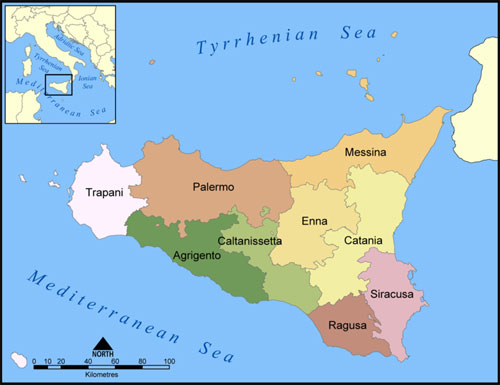This is the first of an investigative series on Sicilian wines. Part Two of this series will be a focus on the young, dominating wine industry of the Etna DOC (Denominazione di Origine Controllata) on east coast of Sicily, on and around Mount Etna.
For most people, the Mediterranean peninsula of Italy conjures metaphors and sensations of gastronomic ecstasy and high culture. The foods and wines are like its history, sated with drama and prudence. From its politics to its geography, the nation is connected by its diversities of culture, and no where are differences more frequently and poignantly in play than the southern region of Sicily.
Set just southwest of the “toe” of Italy is the island of Sicily, a triangular shaped land mass formed largely by volcanic eruptions that formed Mount Etna – Europe’s most active volcano. The topography of the island is sparse, composed of cities and scrubland and coastal vistas saturated in sunlight.
It is a poor place, far from the economic impulses of Milan and Rome, and the quality of the region’s wine industry has suffered for it. Throughout the twentieth century, Sicilian wines were co-opted by the north as blending components for gigantic wine houses that pump out good, but sometimes generic, red and white wines.

Largely because of its weather (no rain after February, hot, dry, windy) and its soil conditions, grapes ripen without much trouble. The island can be a powerhouse when it comes to the amount of wine it makes – it is often the most productive region of Italy.
Now, thanks to a few producers who have been spurred to improve their own wines for a more international palate and gastronomic tourism, vineyards that once produced (literally) boat loads of wine are evolving.Low yields and New World winemaking techniques are being integrated as a basis for a winemaking imperative aimed at quality rather than quantity. However, the introduction of new grape varieties to a market saturated by Old World varieties is also part of what makes Sicily so fascinating, oenologically speaking.
Marsala, Chardonnay, Cabernet Sauvignon, Merlot, and Syrah all do well in Sicily, and how these wines perform on the international scene is an important part of the island’s current, mounting status in the wine world, but it is the unknown varieties that are causing more of a stir lately.
In particular, wines from Carricante, Inzolia, Cattarato, Nero D’Avola, Nerello Mascalese, Nerello Cappuccio, Frappato, and Nocera are garnering the attention of wine experts around the world.
Wines made from these are exotic varieties are intriguing to be sure, and when made with care dispel any doubt in the island’s potential to produce wines of haunting wisdom and clarity.
However, not all of the producers in Sicily are there yet. As I mentioned, it is a poor place, and wine has been a side-companion to food and gatherings for millennia here. The concept that wine can be a commodity is a strange one, and perhaps this is the last obstacle to a definitive oenological future for the island.
New concepts tend to fall on deaf ears when you’re dealing with a culture that has been re-introduced (at times militarily) to foreign opinions for thousands of years. Change is slow here. That being said, as consumers move through Old and New World varietals to discover the individuality of their own palates, they have begun to stop in Sicily. My guess is some of them will probably stay.
This is part one of Benjamin Spencer's series on Sicily. Click here for Part two.






